When it comes to electronics, soldering wires are an essential part for both small-scale and large-scale projects. Whether you’re fixing a broken wire or assembling a custom circuit, the quality of your soldering wire can significantly impact the outcome. After testing various options, we’ve narrowed down the best solder wires for electronics to help you achieve precise and reliable results. In this guide, we’ll cover the top choices available currently in the market.
When selecting solder for electronics, three key factors to consider are:
- Alloy Composition: The ratio of tin to lead affects the solder’s melting point and flow characteristics. A 63-37 tin-lead mix is ideal for smooth, strong joints.
- Flux Content: Flux helps clean and prepare the metal surfaces, promoting better adhesion. A flux content of around 1.8-2% is typical for rosin core solders.
- Melting Point: The temperature at which solder becomes liquid. Lower melting points make the soldering process easier and quicker.
Overview Of The Best Solder Wire
| Product Name | Diameter | Flux Content | Melting Point | Buy Now |
|---|---|---|---|---|
| MAIYUM Rosin Core Solder Wire | Tin 63% | 1.80% | 361F/183C | Check On Amazon |
| Austor Rosin Core Solder Wire | Tin 60%-Lead 40% | 2% | 185°C - 190°C (365°F - 374°F) | Check On Amazon |
| TOWOT Rosin Core Solder Wire | Tin 63% Lead 37% | 2% | 361F/183C | Check On Amazon |
| Kester Solder Wire | 60% Tin / 40% Lead (Product contains Halogen) | 3.30% | - | Check On Amazon Check On Walmart |
| SONEAK Rosin Core Solder Wire | Tin 60%-Lead 40% | 2% | 361F/183C | Check On Amazon |
| ANOTEK Rosin Core Solder Wire | 60% Tin and 40% lead | 2% | 190°C / 374°F | Check On Amazon |
| JWOWO Rosin Core Solder Wire | Tin 63%-Lead 37% | 2% | - | Check On Amazon |
| HengTianMei Solder Wire | Tin 63%-Lead 37% | 1.80% | 361F/184°C | Check On Amazon |
| E ENERSYSTEC Rosin Core Solder Wire | Sn99% Ag0.3% Cu0.7% | 2.50% | 419F 217C | Check On Amazon |
| Weller WSW SnPb Solder Wire | Tin 60% Lead 40% | 2.20% | - | Check On Amazon |
1. MAIYUM Rosin Core Solder Wire
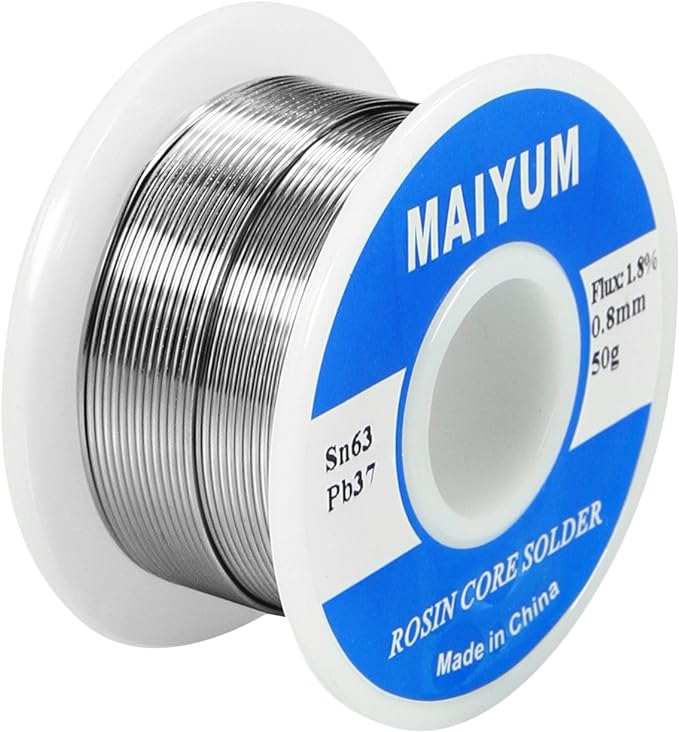
Let’s first talk about the MAIYUM Solder Wire. The 63 % Tin -37 % Lead tin-lead ratio provides a perfect blend for a smooth and reliable soldering experience. The low melting point of 361°F is easy to work with as it gives you that perfect, shiny finish every time. The 0.8mm diameter is thin enough for precision work, yet sturdy enough for strong connections.
The rosin core is like magic glue that helps the solder flow smoothly and adhere to surfaces, ensuring your connections are solid and reliable. The 50g spool is a decent amount to keep you going for multiple projects without running out halfway through. Plus, it’s compact and easy to store—no more tangled messes. If you’re looking for a solder wire that balances performance and value, the MAIYUM Solder Wireone is worth considering
Specifications:
- Alloy Composition: Tin 63%, Lead 37%
- Flux Content:8%
- Melting Point: 361F/183C
- Diameter:8mm
- Spool Weight: 50g
Pros:
- Ideal diameter for precise work
- Excellent flux core promoting strong adhesion
- Compact spool size suitable for multiple projects
- Shiny and professional finish
Cons:
- May require temperature adjustments
- Potential for flux fumes during soldering
2. Austor Rosin Core Solder Wire
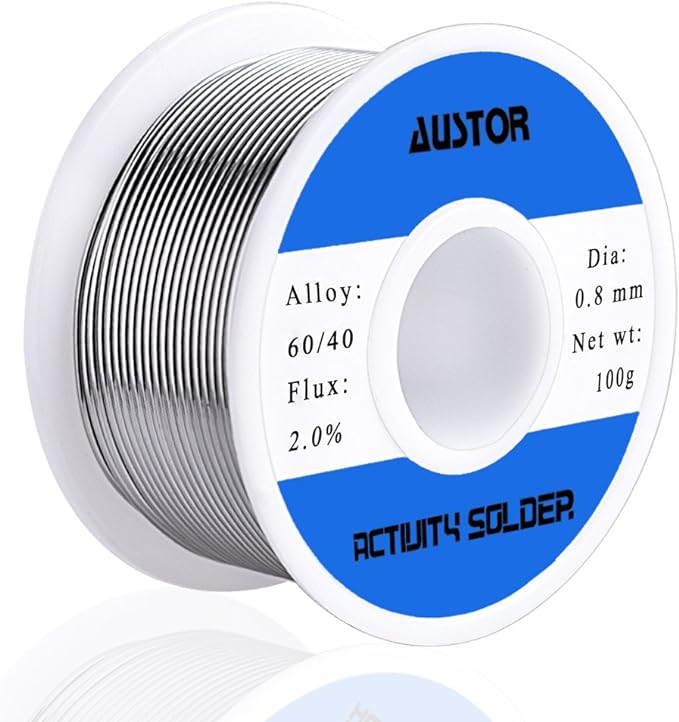
The 2% flux content on the Austor 60% Tin -40 % Lead Solder Wire promises smooth and even heating which is useful for avoiding cold joints and ensuring reliable connections. The 100g spool provides a generous amount of solder, making it a cost-effective option for long-term use. The 60-40 tin-lead ratio offers good conductivity and the 0.8mm diameter is perfect for precise soldering.
This solder wire melts between 185°C and 190°C, making it easy to work with for both beginners and experienced users. It’s great for both small and large-scale projects, and the wire’s consistent thickness helps achieve clean and professional-looking solder joints. However, we did notice that it can sometimes be dull and doesn’t flow as well as some other brands, which might require a bit more effort and heat to work with.
Specifications:
- Alloy Composition: Tin 60%, Lead 40%
- Flux Content: 2%
- Melting Point: 185°C – 190°C (365°F – 374°F)
- Diameter:8mm
- Weight: 100g
Pros:
- Has good conductivity
- Provides smooth heating
- Large spool size
- Has a long shelf life
Cons:
- Requires ventilation
3. TOWOT Rosin Core Solder Wire
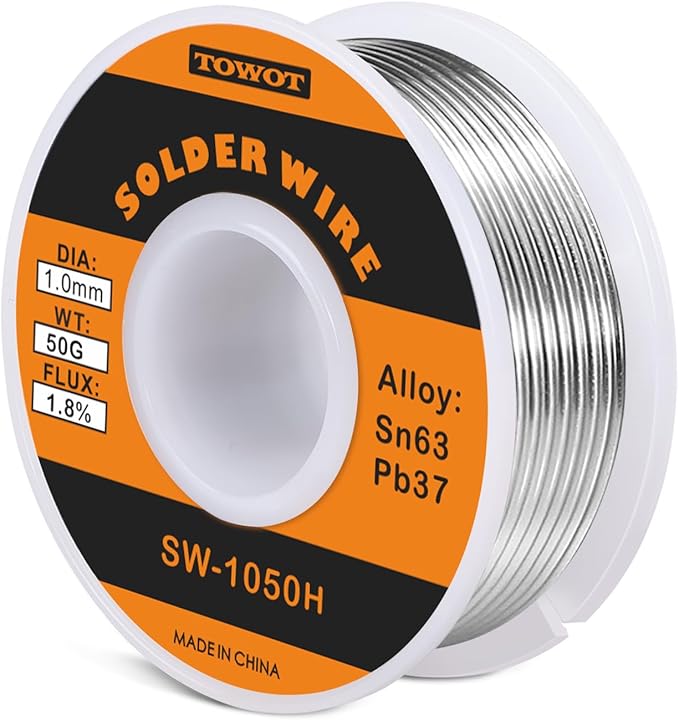
One thing we appreciate about the TOWOT Solder Wire is its consistent performance. It’s perfect for general-purpose electronics work and is easy to use, even for beginners. The 50g spool is adequate for most projects. The rosin core does a great job of wetting leads and improving solder joints, which reduces the chances of cold joints. The 63-37 tin-lead ratio, combined with a 1.8% flux content, provides excellent soldering capability.
The 1.0mm diameter is slightly thicker than some others on the list and is best for heavy-duty solder joints. The low melting point of 361°F (183°C) ensures quick and efficient soldering. This wire flows smoothly and creates strong joints, which is essential for reliable electrical connections. Overall, the TOWOT Solder Wire is suitable for those who need a bit more diameter for stronger joints. However, it’s not the best choice for precision work due to its thickness, and it can sometimes turn dull and grey when cooled, which might affect the aesthetics of your solder joints.
Specifications:
- Alloy Composition: Tin 63%, Lead 37%
- Flux Content:8%
- Melting Point: 361F/183C
- Diameter:0mm
- Weight: 50g
Pros:
- High purity in the Alloy composition
- Strong joints
- Low melting point
- Minimal residue
Cons:
- Aesthetic issues – can turn dull when cooled
4. Kester Solder Wire
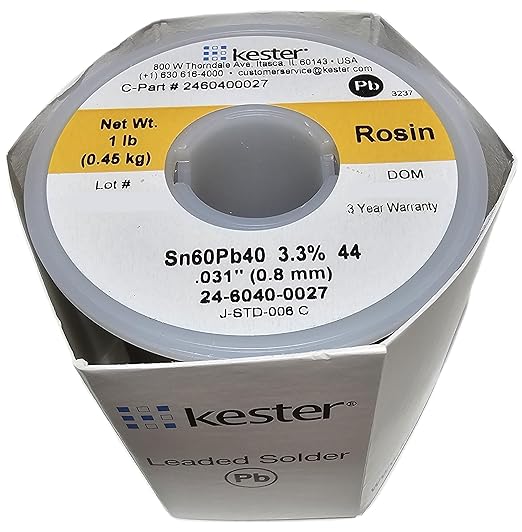
The Performance of the Kester Solder Wire on various materials, like copper and brass was impressive as it provided smooth flow and significantly improved the appearance and quality of our solder joints. The 0.8mm diameter is perfect for working with electronic components, and the quality of the soldering is noticeably better than cheaper alternatives. Even under magnification, the solder retains a bright shine, making it easier to inspect your work.
One downside we encountered was the thick brown residue it leaves, requiring additional cleaning and flux. This might not be a big deal if you’re used to cleaning your work, but it’s an extra step that some might find annoying. Despite this, the solder still performs well overall and is particularly useful for detailed work, like repairing instrument clusters.
Specifications:
- Alloy Composition: 60% Tin / 40% Lead (Product contains Halogen)
- Flux Content:30%
- Diameter:80mm
- Core Type: Rosin Core
- Flux Type: 44 Flux
- Spool Weight: 1 Pound per Spool
- Wire Diameter:8mm
Pros:
- Promises excellent flow quality
- Has the perfect diameter for electronic components
- Retains shine under magnification
- Gives a smooth soldering experience
Cons:
- Requires additional flux
- Heavy spool weight
Buy Now From Amazon Buy Now From Walmart
5. SONEAK Rosin Core Solder Wire
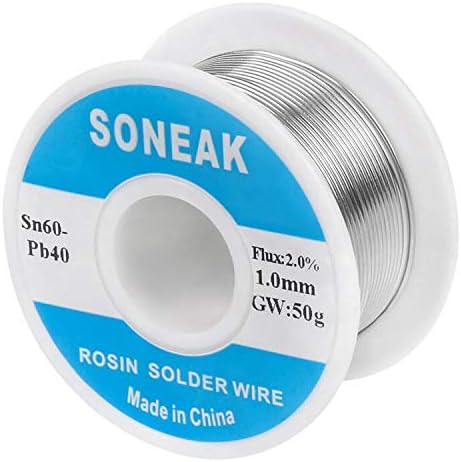
The 1.0mm diameter and 2% flux content of the Soneak Solder Wire make it suitable for general electrical soldering. The lower melting point of 361°F (183°C) is helpful for quick soldering and allows it to flow smoothly, making it easy to work with. It’s a good option for DIY projects and home improvement tasks where precision isn’t as critical.
We also noticed that the solder’s price is quite reasonable, which could make it an attractive choice for those on a budget. However, the need for a higher temperature could make it less user-friendly, particularly for beginners or those with less advanced soldering equipment.
Specifications:
- Alloy Composition: 60% Tin / 40% Lead
- Flux Content: 2%
- Diameter: 1.0mm
- Melting Point: 361°F / 183°C
- Weight: 50g
Pros:
- Lower melting point
- Smooth flow with proper temperature
- Less smoke during use
- Reliable for home improvement tasks
- Fast soldering process
Cons:
- Requires high temperature to flow well
6. ANOTEK Rosin Core Solder Wire
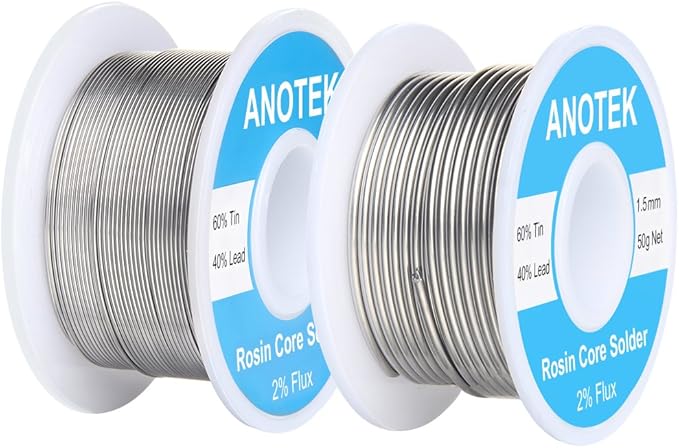
This solder wire from ANOTEK comes in two diameters: 0.6mm and 1.5mm, and is made from a 60% tin and 40% lead alloy. Having a melting point of 374°F (190°C) and 2% flux, it’s designed for various applications, including electronics, stained glass, and jewelry.
The solder’s flow can be problematic, requiring more heat to melt properly and often resulting in a less clean finish. The rosin core, while convenient, can be difficult to clean off, especially for delicate projects like stained glass. For those who need reliable soldering for precise work, this might not be the best choice, but it can still be useful for general purposes.
Specifications:
- Alloy Composition: 60% Tin / 40% Lead
- Flux Content: 2%
- Diameter:6mm and 1.5mm
- Melting Point: 190°C / 374°F
- Core Type: Rosin Core
- Weight: 50g of each diameter
Pros:
- Comes with two diameter options
- Decent flow with proper heat
- Is easy to handle
- Suitable for small repairs
Cons:
- Not suitable for professional use
7. JWOWO Rosin Core Solder Wire
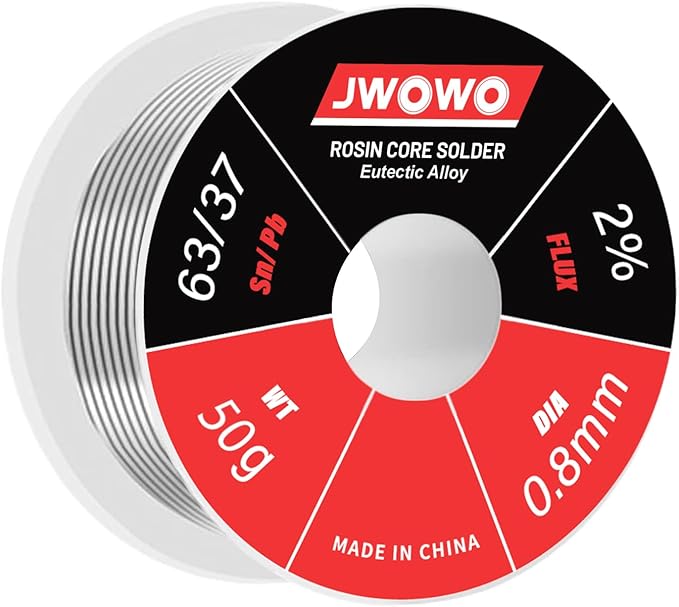
Having 63% tin and 37% lead composition, the JWOWO Solder Wire has the right blend of alloy composition for smooth soldering. The solder wire is pre-fluxed with a 2% rosin core, which means you don’t need extra flux, making it user-friendly for quick jobs. Its 0.8mm diameter and 50g spool offer good control and are handy for precision work.
In terms of performance, this solder wire melts at a relatively low temperature, which helps in achieving strong solder joints quickly. The price is reasonable for the quality you’re getting, and the 1-year warranty is a nice bonus, ensuring you can get a refund if there are any quality issues. Overall, this solder wire is a good pick if you’re doing detailed soldering work.
Specifications:
- Alloy Composition: Tin 63%, Lead 37%
- Flux Content: 2%
- Melting Point: Not specified
- Diameter:8 mm
- Weight: 50g
Pros:
- Easy to use with built-in flux
- 1-year warranty included
- Smooth flow and fast soldering speed
- Good for detailed soldering work
Cons:
- Thin gauge could be less durable
8. HengTianMei Solder Wire
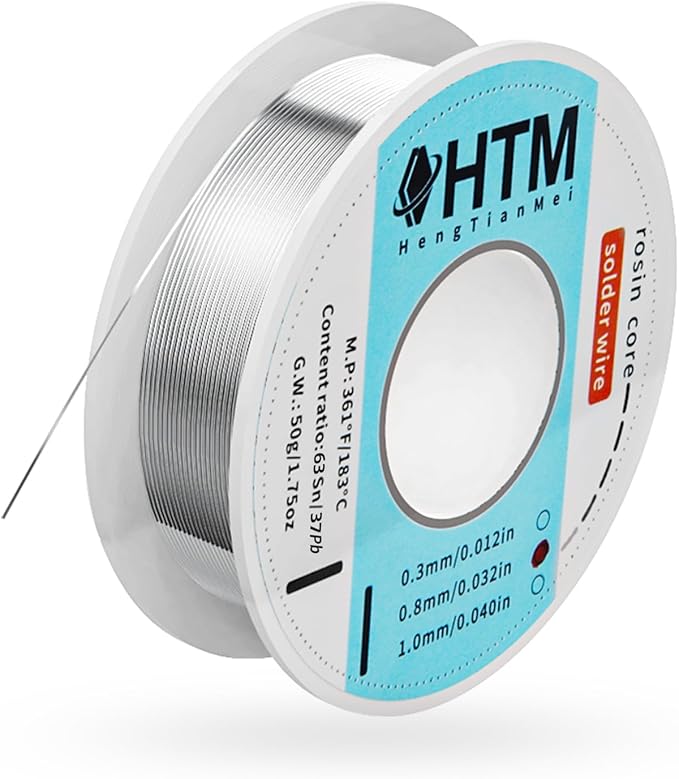
One of the best things about the HengTianMei Solder Wire is its surface-mount technology (SMT) soldering which makes it a great option for detailed electronic work. With its 63% tin and 37% lead composition, a diameter of 0.8mm and 50g weight, it offers good performance and ease of use. It comes with a 1.8% flux core, which is slightly less than other products having 2%, but still sufficient for many applications.
The melting point is around 361°F (184°C) and is advantageous for delicate components, as it reduces the risk of overheating. However, there were concerns about the solder being contaminated, which might affect its performance in critical applications.
Specifications:
- Alloy Composition: Tin 63%, Lead 37%
- Flux Content:8%
- Melting Point: 361°F (184°C)
- Diameter:8 mm
- Weight: 50g
Pros:
- Effective for SMT soldering
- Easy to use with built-in flux
- Nice size for pocket or small projects
- Flows smoothly during soldering
Cons:
- Potential contamination issues
9. E ENERSYSTEC Rosin Core Solder Wire

With 99% tin, 0.3% silver, and 0.7% copper the E ENERSYSTEC Solder Wire is the only Lead-Free Solder Wire on the list. The 0.8mm diameter and the 50g spool are consistent with the other wires we reviewed. This solder wire is designed to be RoHS (Restriction of Hazardous Substances Directive) compliant, which is great for environmentally conscious users.
The melting point of 419°F (217°C) is higher compared to the tin-lead options we tried and makes it suitable for applications where a higher temperature is required. While it performs well with high electrical conductivity and a bright solder joint, the silver content may not offer the benefits expected as the percentage is relatively low. Compared to other solder wires, this lead-free option is a good choice if you need to avoid lead and adhere to RoHS standards. It’s suitable for detailed electronic soldering and offers good performance with a smooth flow.
Specifications:
- Alloy Composition: Sn99%, Ag0.3%, Cu0.7%
- Flux Content:5%
- Melting Point: 419°F (217°C)
- Diameter:8 mm
- Weight: 50g
Pros:
- Is Environmentally friendly
- The quality is long-lasting
- Has a bright solder joint and strong pad
- Is lead-free and RoHS-compliant
Cons:
- Limited to specific applications where lead is not a limiting factor
10. Weller WSW SnPb Solder Wire
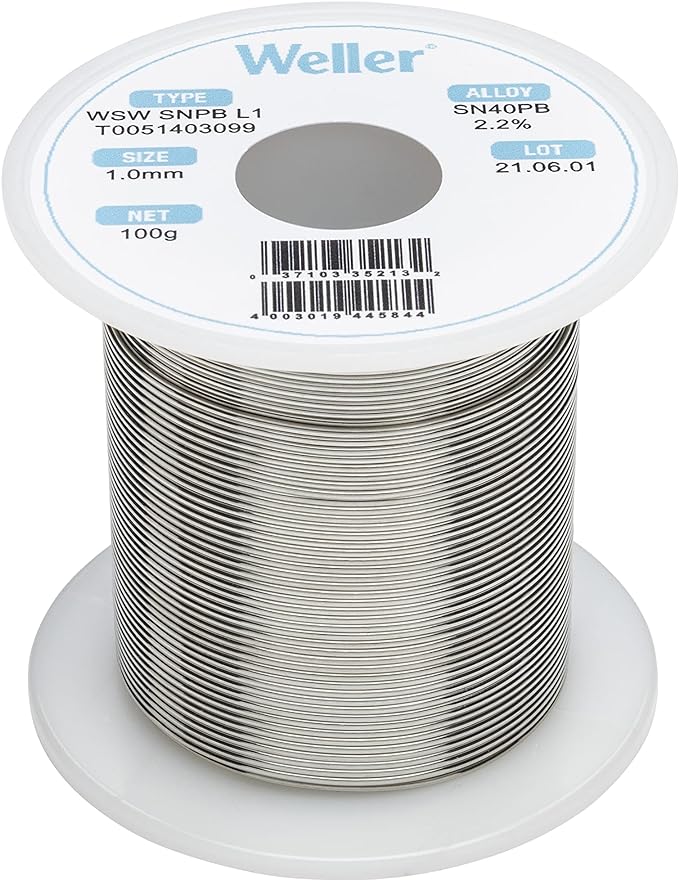
The Weller WSW SnPb Solder Wire features a unique 2.2% continuous flux core that ensures consistent flux coverage for better tip wetting and smoother solder flow. This leads to high-quality solder joints that are less prone to cracking, even on challenging surfaces. The solder wire’s 60% tin and 40% lead composition provides reliable strength and durability, making it ideal for extensive projects and heavier-duty tasks. Its 1.0mm diameter is suitable for larger components, ensuring strong connections where they matter most.
Moreover, the 100g spool offers ample solder for multiple projects, reducing the need for frequent replacements and effectively lowering project costs. The patented alloys enhance heat performance, crucial for various soldering scenarios, and reduce tip consumption by up to 70%. This not only leads to lower maintenance costs but also boosts efficiency, saving significant labor time and resources. Such advantages make the Weller solder wire an excellent choice for professionals looking to optimize their soldering operations for long-term success.
Specifications:
- Alloy Composition: Tin 60%, Lead 40%
- Flux Content:2%
- Melting Point: Not specified
- Diameter:0 mm
- Weight: 100g
Pros:
- Heat performance is optimized
- 2% continuous flux core for consistent performance
- Good for larger components and heavy-duty tasks
- Large spool size for extensive projects
Cons:
- Less suitable for very delicate soldering tasks
Choosing The Perfect Solder Wire: Expert Buying Tips
1. Alloy Composition: It refers to the metals used in the solder wire. The most common solder wires for electronics are made from a combination of tin and lead, known as 60/40 or 63/37 solder. There are also lead-free options available, which typically use a mix of tin with other metals like silver, copper, or bismuth.
- 60/40 (Tin/Lead): This is the most common composition for electronics. It contains 60% tin and 40% lead. This mix offers a good balance of melting point and flow characteristics, making it easy to work with and reliable for most electronic repairs.
- 63/37 (Tin/Lead): Contains 63% tin and 37% lead. It has a slightly lower melting point than 60/40 and is known as a eutectic alloy, which means it transitions from solid to liquid at a single temperature, providing a smoother flow.
- Lead-Free Alloys: These typically include 99.3% tin with 0.7% copper, or other variations like tin-silver-copper (SAC) alloys. Lead-free solders are increasingly used due to health and environmental regulations, though they generally have a higher melting point and require more heat to work with.
If you’re working in a regulated environment or prefer to avoid lead, opt for lead-free solder. For general electronics and ease of use, 60/40 or 63/37 solder is often preferred due to its lower melting point and smooth flow.
2. Flux Content: Flux is a chemical agent used to clean the metal surfaces and help the solder flow smoothly. The flux core within the solder wire ensures better adhesion and reduces oxidation during the soldering process.
- Rosin Core: Commonly used in electronics soldering, rosin-based flux is ideal for most electronic connections. It’s effective at cleaning and preventing oxidation, but may require additional cleaning afterward to remove residue.
- Flux Content Percentage: Typical flux content ranges from 1% to 5%. Higher flux percentages generally offer better flow and wetting properties but might leave more residue.
Choose solder with a rosin core for electronics. Ensure the flux content is sufficient for your needs—generally, 2% to 3% is standard for most applications. If you work in a sensitive environment, consider solder with a low-residue or no-clean flux.
3. Melting Point: It is the temperature at which the solder turns from solid to liquid. This is crucial for ensuring that the solder can be applied effectively without damaging components or the circuit board.
- 60/40 Solder: Melts around 370°F (188°C). This relatively low melting point makes it suitable for most electronics work and reduces the risk of overheating components.
- Lead-Free Solder: Generally has a higher melting point, around 430°F to 450°F (220°C to 230°C). This higher temperature can be more challenging to manage, especially for delicate components.
For standard electronics, 60/40 or 63/37 solder is preferred due to its lower melting point. If you’re working with high-temperature components or in an environment where lead is prohibited, lead-free options are necessary, but be prepared for higher temperatures.
4. Diameter: It refers to the thickness of the solder wire. The diameter affects how the solder flows and how easy it is to control during the soldering process.
- Thin Wires (e.g., 0.6mm to 1.0mm): Ideal for fine electronics work and detailed soldering. Thin wires provide precise control and are suitable for small components and intricate jobs.
- Thicker Wires (e.g., 1.5mm and above): Better for larger joints or applications requiring more solder. Thicker wires can be less precise but are useful for larger-scale repairs or connections.
For general electronics, a diameter of around 0.6mm to 1.0mm is versatile and easy to handle. If you often work with larger components or need to fill bigger gaps, consider thicker wires. Ensure the diameter matches your typical soldering tasks for the best results.
5. Wire Length And Spool Size: The length of the solder wire and the size of the spool impact how long you can work before needing a replacement. Larger spools are often more cost-effective in the long run, especially if you do a lot of soldering.
- Spool Size: Common spool sizes range from small (e.g., 25 grams) to large (e.g., 1 kilogram). Larger spools offer more solder and are generally more economical for frequent use.
- Wire Length: A longer wire length means fewer interruptions during work. Check the spool’s total length to ensure it suits your needs.
If you frequently solder, opt for larger spools to reduce the frequency of replacements and often benefit from a better price per unit. For occasional use, smaller spools are sufficient and easier to handle.
6. Soldering Temperature Compatibility : Compatibility with your soldering equipment and its temperature range is essential for effective soldering. Different solders require different temperatures, and ensuring your solder matches your equipment’s capabilities can prevent overheating or insufficient melting.
- Temperature Range: Check the temperature range recommended for the solder you choose. Ensure your soldering iron or station can reach and maintain this temperature accurately.
Match the solder’s melting point with the capabilities of your soldering iron or station. For lead-free solders with higher melting points, ensure your equipment can handle the extra heat.
7. Environmental And Health Considerations: Certain solders contain lead, which can be harmful to health and the environment. Lead-free alternatives are available and are often preferred for compliance with health and environmental regulations.
Specifications:
- Lead-Free Options: Many modern solders are designed to be lead-free, using alloys such as tin-silver-copper (SAC). These are suitable for environments where lead is restricted or for safer use.
- Safety Warnings: Products containing lead should come with appropriate warnings and instructions for safe handling.
If you’re concerned about health and environmental impact, choose lead-free solder. Be aware of safety precautions if using leaded solder and ensure proper ventilation and protective measures.
8. Solder Flow And Wetting Properties: Solder flow refers to how well the solder spreads and adheres to surfaces, while wetting properties describe how the solder interacts with the metal surfaces being joined. Good flow and wetting are crucial for creating strong, reliable joints.
- Flow Characteristics: Look for solder that melts and spreads smoothly without forming clumps or beads. This ensures even application and effective joining of components.
- Wetting Properties: Good wetting means the solder bonds well to the surfaces, reducing the risk of weak or unreliable connections.
Test solder flow and wetting properties before committing to a large quantity. A solder with superior flow and wetting will make your work easier and improve the quality of your joints.
9. Residue And Clean-Up Requirements: Solder can leave behind residues after melting, which may need to be cleaned off to avoid potential interference with electronic components or circuit performance.
- Residue Type: Some solders leave a visible residue that requires cleaning, while others are designed to leave minimal or no residue.
- Cleaning Requirements: Consider the ease of removing any residues left by the solder, as some may require specialized cleaners or additional steps.
Choose solder with minimal residue if you prefer a cleaner finish and less post-soldering work. If cleaning is required, ensure you have the necessary tools and cleaners to handle the residue effectively.
Also check -
- Best soldering stations
- Best butane soldering iron
- Desoldering stations
- The 10 Best Soldering Flux for Electronics Reviews & Buying Guide
- Soldering Flux Types | Rosin, Water Soluble, No-Clean
[/su_note
FAQs:
Leaded solder contains a mixture of tin and lead, such as 60/40 or 63/37, and is known for its lower melting point and smooth flow. Lead-free solder, often made from tin combined with other metals like silver or copper, has a higher melting point and can be more challenging to work with but is preferred for health and environmental reasons.
The diameter of the solder wire affects its ease of use and the precision of your soldering. Thin wires (0.6mm to 1.0mm) are ideal for fine, detailed work on small components, while thicker wires (1.5mm and above) are better for larger joints or more substantial connections. Choose the diameter based on the size and type of components you’ll be working with.
Flux is a chemical agent that cleans and prepares the metal surfaces to be soldered, preventing oxidation and helping the solder flow smoothly. It improves the bond between the solder and the components. Most solder wires come with a flux core, but you may need additional flux for certain tasks or to clean up residues.
For most electronics work, a solder with a melting point around 370°F (188°C), such as 60/40 solder, is ideal. This lower melting point is easier to manage and reduces the risk of damaging sensitive components. Lead-free solders, with melting points around 430°F to 450°F (220°C to 230°C), are suitable if lead is restricted or for specific applications.
Solder residue, especially from rosin-based flux, may need to be cleaned to prevent interference with electronic circuits. Use isopropyl alcohol and a brush or a dedicated flux remover to clean the area. For no-clean fluxes, minimal residue is left, and extensive cleaning may not be necessary.
Yes, leaded solder contains lead, which can be harmful if inhaled or ingested. It is important to work in a well-ventilated area, avoid direct contact with the solder, and wash your hands thoroughly after handling. Lead-free alternatives are available and are a safer option for health and environmental reasons.
Solder wires designed for electronics are not suitable for plumbing or other non-electronic applications. Plumbing solder typically has different alloys and fluxes suited for pipe fittings and connections. Use solder specifically designed for your application to ensure proper performance and safety.
The flow of solder is influenced by its alloy composition, flux content, and the temperature at which it is used. Solders with higher flux content and proper melting temperature flow more smoothly. The cleanliness of the surfaces being soldered and the quality of the solder also play a role.
Store solder wire in a cool, dry place away from moisture and excessive heat to prevent oxidation and contamination. Keeping it in a sealed container or original packaging helps protect it from environmental factors that can degrade its quality.
If the solder doesn’t flow well, check the temperature of your soldering iron and ensure it matches the melting point of the solder. Ensure the surfaces being soldered are clean and free of oxidation. If using lead-free solder, confirm that your equipment can reach the higher temperatures required. If problems persist, consider using a solder with a higher flux content or a different alloy for better performance.
Conclusion
In conclusion, this comprehensive guide on the best solder wires for electronics aims to streamline your decision-making process by offering detailed insights into crucial factors like alloy composition, flux content, melting point, and diameter.
We’ve also highlighted additional considerations such as wire length, temperature compatibility, and environmental impacts to ensure you have a well-rounded understanding of what to look for. Whether you’re a hobbyist or a professional, the information provided will help you select the solder wire that best suits your specific needs, ensuring both effective soldering and a successful project outcome.


2 Responses
Thank you, this article was just what I was looking for in my search for better soldering joints. I was looking to find what is considered the best type of solder for the DIY I work on. thank you very much. Keep posting items like this. I will be searching for your review on type of soldering irons next. Again thank you very much.
If you do buy Kaina solder, you need to be sure it’s the one with the blue and white label. As the same company makes a solder that is totally useless for electronics.
Buy the thinnest you can get.